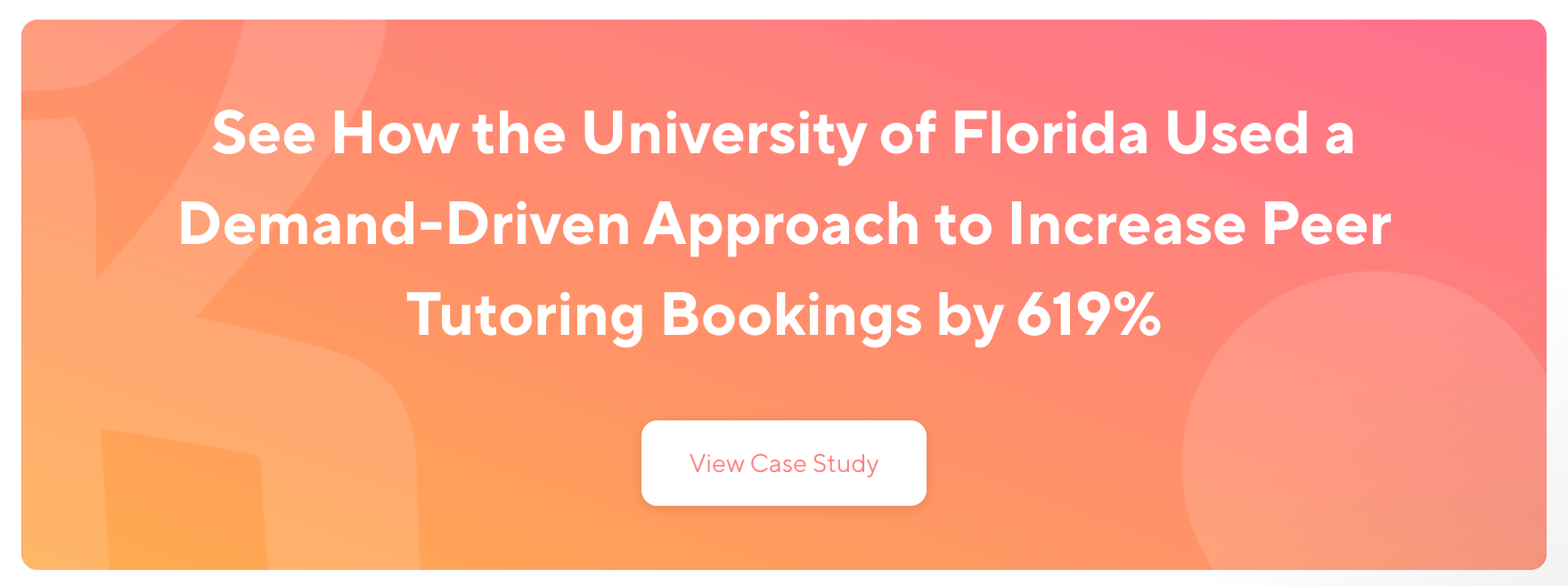5 min read
Planning Ahead: Hiring Tutors for the Next Academic Year
By: Marissa Bastian on Mar 30, 2021 12:49:39 PM

As the semester begins to wind down and summer approaches, budgets for the next academic year will be finalized and (hopefully) shared with program coordinators. This part of the year is a great time to prepare for next year and determine what hiring decisions you’ll need to make.
Are you losing many tutors to graduation? Are there new courses or programs that you’ll need to support next year? What were the highest-demand courses this year and did you have appropriate staffing? There are so many things to consider as one year ends and preparation for the next begins. Let’s take a look at a few ways that you can approach this process.
Future You Will Thank You
If you know your budget for the next academic year early enough, you can get a head start and actually complete your hiring before the current year is even over. Consider requesting a list of all eligible students from your Registrar’s Office; constrain your list to any requirements you have for your tutors: minimum GPA, class year, majors, etc. Then you can use this list to email those pre-approved students to encourage them to apply to be tutors for the next year. Include in the email the application (or a link to the job posting), important dates and deadlines, and any other information or requirements that the applicants would need to know, such as interview dates.
Conducting your hiring process during spring semester for the next year means that you can hit the ground running when the fall semester starts. As soon as tutors complete training, you’ll have a full staff of tutors ready to start meeting with students—no lag time or tutoring with a half-staffed center. Trying to hire during those first few weeks of the semester can be difficult, as you’re competing with all other open on-campus positions, students trying to get back into the swing of things, and more. When you hire in the spring, you’ll be able to start the upcoming fall semester with your full staff in place.
Of course, if you aren’t given access to or confirmation about your budget for the upcoming year, hiring in the spring will either be difficult or impossible. Another thing to note about hiring in the spring for the next year is that students’ Federal Work Study eligibility may change over the summer. So, if you budget based on how many FWS vs. school-funded tutors you can hire, you’ll want to build in a buffer for any possible FWS-eligibility changes that may occur in the summer months — either tutors no longer being eligible for FWS or other tutors now becoming eligible. Maintaining close communication with your student employment office is critical for “upcoming year” hiring. If not, you can easily find yourself going over budget before the year has even begun.
However, if you know your budget, you connect with student employment regularly, and you schedule your training for early in the semester, your students can reap the benefits of an early start to tutoring. Not having to wait until the second or third week of the semester means students have earlier access to tutoring and, thus, a better chance of a successful start to the term.
New Year, New Hires
No two schools’ budgeting processes are the same, so if you aren’t able to confirm what your next year’s budget will be during spring semester, completing your hiring in advance may not be possible. In that case — or if you just prefer to wait until late summer or fall semester — you’ll likely have less time for your hiring period. Make sure that your application (or online job posting) is finalized and posted well in advance of the first day of classes so students can view it before they get back to campus and can apply sooner rather than later. Enforce strict deadlines so you’re not delayed and waiting on applications to be submitted before you can begin interviewing, hiring, and training new tutors. If possible, you may even want to hire on a rolling basis, so you’re not forced to wait for all applications before you begin interviewing applicants. Anything you can do to streamline the process will help.
One of the benefits of hiring at the start of the academic year is that all of the applicants’ FWS eligibility should be finalized by then. There shouldn’t be any changes once they’re back on campus and you’ll know exactly who is paid by FWS and who will need to be paid through institutional funding. That takes some of the guesswork out of the process. Another benefit is that you won’t lose any tutors over the summer to changed minds — there are almost always a couple of tutors who decide to accept an internship or other position after they’ve agreed to tutor. Waiting until the start of the academic year lets you know who is serious about being a tutor, who is truly available, and who isn’t just accepting until “something better” comes along. But, honestly, what could be better than being a tutor?
While you may have a partial staff left over from the previous year, you don’t want your center to be running at less-than-full strength for too long. Those first few weeks of the semester are often some of the busiest, with first-year students stressing as they get acclimated to college-level courses and expectations. You want to make sure that you have enough tutors to be able to meet the needs of not only the first-years, but returning students, as well. If you aren’t able to begin your hiring process until the semester begins, this can impact your ability to have enough tutors for the highest-demand courses at the start of the semester.
A compromise between these two hiring processes would be to conduct your hiring in late summer — after the new fiscal year begins and your budget has been finalized but before the semester begins and students return for classes. This would allow you to have your budget confirmed, avoid potential FWS eligibility concerns, and you can provide a full staff of tutors by the time classes begin. However, this does mean that you likely cannot interview applicants in person, as many may live far away from campus.
Finding The Right Fit
The timing of each hiring process has its benefits and challenges, as outlined above. And, if you are responsible for multiple peer education programs, you may find that each program has different needs and a different process that works best for hiring. Your hiring timeline for SI leaders might not work as well for hiring your peer tutors or academic coaches. Closely consider your budget, the sources of your student employment funding (institutional funds or Federal Work Study), how many new tutors you typically need to hire each year, when you can conduct your training, and how soon after the semester starts that you’re expected to offer tutoring (e.g., the first week of classes, the second week, etc.).
An added complication to hiring new tutors is trying to anticipate the subjects areas that will be most needed for the term. You likely have historical data to predict what the high-demand courses will be (often high-DFW courses), but there will always be some courses or majors that you simply can’t cover with your tutors. Perhaps there isn’t enough demand to warrant a tutor dedicated to that discipline, or maybe no one who applied can tutor a course or courses that you typically have some coverage for. In these cases, you’ll need to determine where you’ll refer students looking for support in those areas.
These outlier courses can prove difficult to support with a staffed tutoring program, as you have only so much control over what your tutors cover. You are often at the mercy of your applicants and what that year’s staff can tutor. For more information about adding a managed tutoring program to supplement the excellent work of your staffed tutors, click the link below.
No matter which hiring process you choose for your tutoring program, keep a few things in mind. Availability is important, but passion and drive for helping others can often more than make up for having limited availability and a busy schedule. Tutors who have both breadth and depth in their course coverage are difficult to find; having either breadth or depth in a single tutor can be a major asset to your staff. Think of your tutoring staff like a sports team or orchestra, with various members working together to create the right harmony—whether athletically or musically. Through your hiring process, you can create a harmonious staff by finding the right mixture of tutors who will bring various strengths, personalities, and passions to your tutoring program.
Related Posts
Assessing Your Tutoring Program Outline: Part 2
In our last blog post on assessment, we discussed operational objectives and student surveys. In this companion post, we’ll delve into student...
Leveraging Peer Coaching to Support Students’ Mental Health
While the types of peer programs on campuses vary, they all have one thing in common: whether it’s the program’s main focus or a by-product of the...
Telling Your Tutoring Program’s Story Through Assessment: Part 1
Controlling the narrative of your tutoring program is important for a variety of reasons. Quite simply, you (and your team) are best positioned to...
